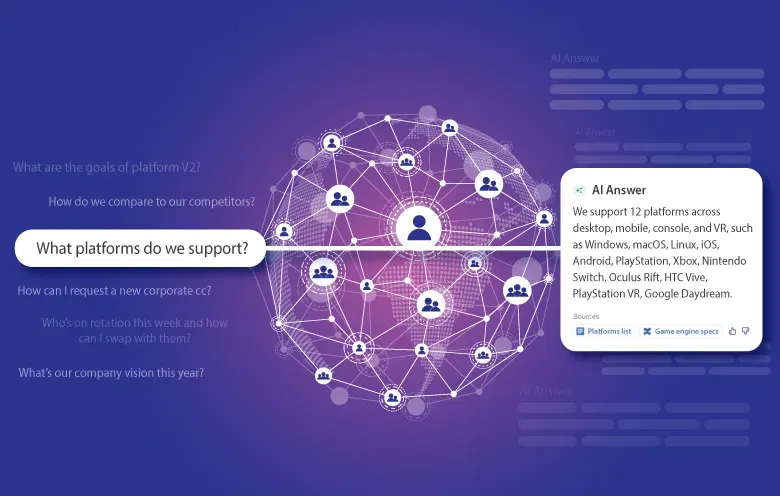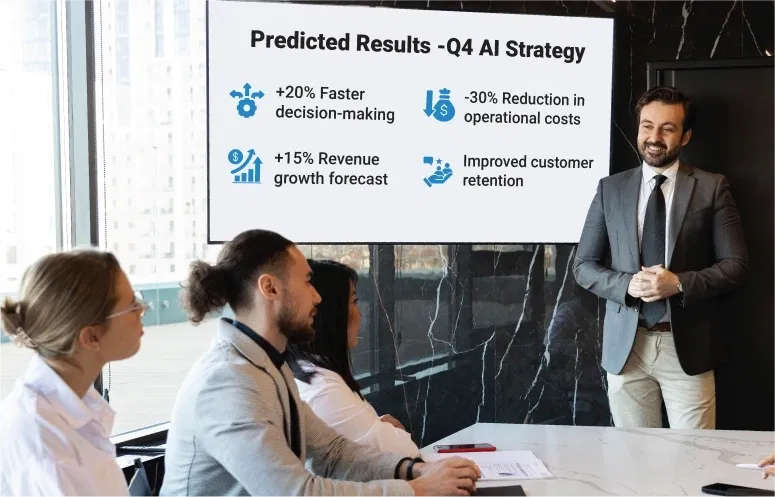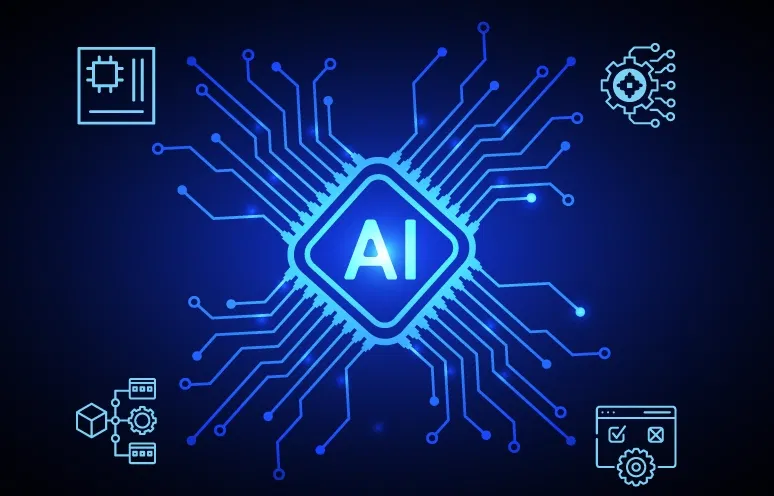Information overload is a constant challenge for enterprises in today’s digital age. According to IDC report, a knowledge worker spends about 2.5 hours per day, or roughly 30% of a workday, searching for information. Traditional keyword-based search systems fall short in delivering precise results, leading to frustration and inefficiency. However, a paradigm shift is underway with the integration of generative AI solutions into enterprise search ecosystems.
In this blog, we’ll explore the challenges, solutions, practical applications of generative AI in enterprise search, and how generative AI supercharges employee experience. We will go through these with a special focus on Needle, a leading GenAI platform.
By 2026, more than 80% of enterprises will have used generative AI APIs and models and/or deployed GenAI-enabled applications in production environments, up from less than 5% in 2023.
Source: Gartner
Challenges with applying generative AI for businesses
Despite the hype around generative AI, significant practical and technical challenges exist when deploying these tools at scale within enterprises. Here are some of the hurdles:
- Data privacy and compliance: Enterprises have distinct data privacy, compliance, and security requirements. Ensuring that generative AI adheres to these standards is crucial.
- Accuracy and trust: Questions remain about the accuracy of generated content, traceability, auditability, and potential hallucination issues. How can we trust the results produced by generative models?
- Scalability and resource intensiveness: High computational costs, infrastructure demands, and scalability issues hinder the widespread adoption of generative AI solutions. Addressing these challenges is critical for successful deployment.
- Integration with existing systems: Compatibility issues and data silos pose challenges in seamlessly integrating generative AI with enterprise systems. Overcoming these obstacles is essential for optimizing workflow efficiency.
- Ethical and bias concerns: Biases in training data, ethical dilemmas, and potential misuse raise concerns about the responsible deployment of generative AI. Enterprises have unique needs for this.
How generative AI transforms enterprise search
Large language models (LLMs) and generative AI have revolutionized enterprise search, promising enhanced search experiences. However, current LLM outputs may need more reliability for enterprise use, occasionally generating responses based on flawed or biased information.
Needle, a pioneering generative AI platform, stands out by serving as a crucial link between enterprise sources and vector databases. It harnesses the power of open-source LLMs to enable contextually aware semantic search capabilities. By mastering the intricacies of natural language, Needle ensures search experiences that are not just accurate, but also intuitive.
Suggested: Want to know how Needle transforms enterprise search and employee experience?
Contextually aware enterprise data
One of the critical strengths of generative AI solutions is their ability to comprehend and analyze unstructured data. Needle’s advanced algorithms can contextualize enterprise data across various sources, including documents, emails, and databases. This contextual awareness enhances search accuracy by delivering results that align with the user’s intent, even amidst ambiguous queries.
Have you ever realized that you could be in the top 18% of organizations just by using unstructured data? How?
Gartner defines unstructured data as content that does not adhere to predefined rules commonly utilized by computers for identification and classification. It encompasses textual and non-textual content, including handwritten text in images. Moreover, unstructured data may also be present in non-relational databases like NoSQL.
Common documents with unstructured data examples include:
- Images
- Emails
- Memos
- Articles
- Websites
- Text messages
- Customer chats
- Legal contracts
- Simple text files
- Discussion forums
- Scientific research
- Social media posts
- Handwritten letters
- Call center transcripts
- Internal slack message threads
- Some programming/scripting languages
Research estimates that unstructured data constitutes a staggering 80-90% of new enterprise data. Surprisingly, only 18% of organizations harness its power. The remaining 82% miss out on their most valuable resource.
Where do you want to fall?
While you mull about this question, let’s continue with how generative AI transforms enterprise search.
Semantic search with LLMs
By leveraging vector embeddings, Needle retrieves context using semantic search. It enhances the transformer model’s output at speed and scale. Such enterprise-specific fine-tuned embeddings then combine with traditional information retrieval methods and advance personalization to create a system that elevates enterprise search capabilities.
Flexible and secure search experiences
When it comes to data access and retrieval, enterprises need robust security measures that can adapt to diverse regulatory frameworks. Needle understands this need and places data security and privacy at the forefront. It implements encryption protocols and access controls, ensuring that your data remains secure. Furthermore, its flexible architecture allows seamless integration with your existing enterprise systems, minimizing disruption to your workflow processes.
Suggested: Learn how Needle searches and analyzes documents with generative AI capabilities
Generate summarized answers from multiple documents by leveraging LLMs
Needle comes with generative AI question-answering capability powered by powerful search technology, open-source LLMs, and generative AI technologies. With such solid support, Needle equips employees, support staff, and knowledge workers with precise, tailored responses to intricate search inquiries across enterprise knowledge documents. Below is a high-level architecture of how Needle generates summarized answers.
Benefits of Needle
- Saves time as you don’t have to read the documents yourself.
- Gives accurate answers to your questions, even if they are complex.
- Improves your understanding of documents by question-answering with AI.
- Helps to generate lists of important keys, notes, points, to-do tasks, questions, and follow-up eligible meetings from larger/longer discussions.
- It can also help create epic stories, fill timesheets, and work with an integrated Jira plugin supported on Needle without leaving the page.
Business impact you will realize with Needle
- Helps to make crucial decisions quickly
- Improves collaboration without affecting focus for other crucial tasks
- Saves time, resources and money for longer term
- Task completion before time
- Gives a sense of achievement
Suggested: Learn how intelligent document processing revolutionizes business operations and efficiency.
Use Cases of Generative AI-Enhanced Enterprise Search and Answers
Let’s explore some practical uses of generative AI:
1.Sales and marketing:
- Targeted messaging: Analyze customer data and generate personalized messages for higher conversion rates.
- Automate repetitive tasks: Free up sales reps’ time by automating lead qualification and appointment scheduling.
- Gain insights into customer behavior: Tailor marketing campaigns based on customer interactions.
2.Customer service:
- Understand customer intent: Generative AI comprehends nuances in human language, leading to efficient issue resolution.
- Provide personalized solutions: Replace generic interactions with human-like conversations.
3.Data and analytics:
- Break down data silos: Seamlessly integrate diverse data sources for better decision-making.
- Extract meaningful insights: Analyze large datasets to identify trends and optimize operations.
4.Knowledge management and training:
- Transform employee onboarding: Personalize training materials and provide real-time answers.
At last, how Generative AI supercharges employee experience
Generative AI transforms enterprise search and supercharges employee experience across various domains. Let’s delve into how the integration of generative AI solutions, exemplified by Needle, enhances the employee journey.
Enhanced productivity: Through AI-powered question-answering and knowledge retrieval, Generative AI platforms like Needle retrieve accurate information. Thus, it saves significant time spent on manual search tasks.
Improved decision making: Generative AI empowers employees to make informed decisions swiftly by providing personalized and summarized insights from vast datasets.
Streamlined communication: Generative AI enables natural language understanding and conversation, facilitating seamless communication between employees and systems.
Personalized learning: Generative AI enhances personalized learning experiences by providing tailored, contextually relevant insights and knowledge retrieval for individual learners.
Effective customer service: Generative AI equips customer support executives with accurate and prompt responses to customer inquiries, significantly enhancing customer satisfaction and fostering loyalty.
By leveraging GenAI, enterprises can create an environment conducive to employee growth, innovation, and satisfaction. As organizations prioritize employee experience as a key driver of success, embracing this technology becomes imperative to stay ahead in the competitive landscape.
Ready to boost search with generative AI?
In conclusion, integrating generative AI solutions, such as Needle, holds tremendous potential for revolutionizing enterprise search and knowledge management. By harnessing the power of LLMs and advanced natural language processing techniques, Needle enables contextually aware, secure, and flexible search experiences. As organizations strive to navigate the complexities of the digital landscape, embracing generative AI is essential to unlock actionable insights and drive innovation.




